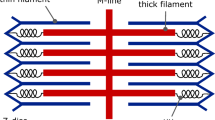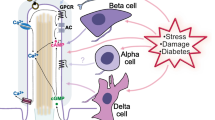Summary
Modulation of β-adrenergic receptors and their ability to respond to β-receptor stimulation was studied in cultures of adult and neonatal rat cardiac myocytes. The radioligand iodocyanopindolol (125I-CYP) was used to identify β-adrenoceptors on the intact cells.125I-CYP was found to bind to the receptors in a stereospecific and saturable manner. Freshly isolated neonatal and adult myocytes both had a receptor density of approximately 50 fmol/mg protein. The number of β-receptors per milligram protein was similar during a 10-d culture period for adult myocytes but increased after a 5-d culture period for neonatal myocytes. Both cell types responded to β-receptor stimulation with isoproterenol by a twofold increase in the concentration of cAMP and this response increased with time in culture. The number of receptors as well as the response to isoproterenol was similar for neonatal myocytes cultured on laminin, collagen type I, or on uncoated culture dishes. From these data we conclude that cultured cardiac myocytes maintain functional β-receptors as they progress into culture, and the expression of β-receptors is not influenced by culture substrates.
Similar content being viewed by others
References
Alexander, R. W.; Williams, L. T.; Lefkowitz, R. J. Identification of cardiac adrenergic receptors by (−)-(3H)-alprenolol binding. Proc. Natl. Acad. Sci. USA 72: 1564–1568; 1975.
Atlas, D.; Hanski, E.; Levetzki, A. Eighty thousand β-adrenergic receptors in a single cell. Nature 268: 144–146; 1977.
Barovsky, K.; Brooker, G. (−)-(125I)-Iodopindolol, a new highly selective radioiodinated β-adrenergic receptor antagonist: measurement of β-receptors on intact rat astrocytoma cells. J. Cyclic Nucleotide Res. 6:297–307; 1980.
Borg, T. K.; Rubin, K.; Lundgren, E., et al. Recognition of extracellular matrix components by neonatal and adult cardiac myocytes. Dev. Biol. 104: 86–96; 1984.
Clark, C. M., Jr.; Allen, D. O.; Clark, J. F. Appearances of responses to glucagon in cultured neonatal rat heart cells. Endocrinology 100: 989–993; 1977.
Clark, W. A., Jr.; Zak, R. Assessment of fractional rates of protein synthesis in cardiac muscle cultures after equilibrium labeling. J. Biol. Chem. 256: 4863–4870; 1981.
Claycomb, W. C.; Burns, A. H.; Shepherd, R. E. Culture of terminally differentiated ventricular cardiac muscle cell: Characterization of exogenous substrate oxidation and the adenylate cyclase system. FEBS Lett. 169: 261–266; 1984.
Claycomb, W. C.; Palazzo, M. C. Culture of terminally differentiated adult cardiac muscle cell: A light and scanning electron microscope study. Dev. Biol. 80: 466–482; 1980.
Cleaver, J. E. Sensitivity of excision repair in normal human, xeroderma pigmentosum variant and cockayne's syndrome fibroblasts to inhibition by cytosine arabinoside. J. Cell. Physiol. 108: 163–173; 1981.
Daly, J. W. Forskolin, adenylate cyclase, and cell physiology: An overview. In: Greengard, P.; Robison, G. A., eds. Advances in cyclic nucleotide and protein phosphorylation research, vol. 17. New York: Academic Press; 1984: 81–89.
Dax, E. M.; Partilla, J. S. Adrenergic ligand liposolubility in membranes. Direct assessment in a Beta-adrenergic binding system. Mol. Pharmacol. 22: 5–7; 1982.
Engel, G.; Hoyer, D.; Berthold, R., et al. (±)-(125I)cyanopindolol, a new ligand for β-adrenoceptors: Identification and quantitation of subclasses of β-adrenoceptors in guinea pig. Naunyn-Schmiedeberg Arch. Pharmacol. 317: 277–285; 1981.
Ezrailson, E. G.; Garber, A. J.; Munson, P. J.; et al. (125I)-Iodopindolol: a new β-adrenergic receptor probe. J. Cyclic Nucleotide Res. 7: 13–26; 1981.
Harden, T. K.; Wolfe, B. B.; Molinoff, P. B. Binding of iodinated beta adrenergic antagonists to proteins derived from rat heart. Mol. Pharmacol. 12: 1–15; 1976.
Harper, J. F.; Brooker, G. Femtomole sensitive radioimmunoassay for cyclic AMP and cyclic GMP after 2'O acetylation by acetic anhydride in aqueous solution. J. Cyclic Nucleotide Res. 1: 207–218; 1975.
Karliner, J. S.; Simpson, P. C.; Taylor, J. E., et al. Adrenergic receptor characteristics of cardiac myocytes cultured in serum-free medium: Comparison with serum supplemented medium. Biochem. Biophys. Res. Comm. 128: 376–382; 1985.
Kasten, F. H. Mammalian myocardial cells. In: Krause P. F.; Patterson, M. K., Jr., eds. Tissue culture methods and applications. New York: Academic Press, 1973: 72–81.
Kleinman, H. K.; McGarvey, M. L.; Liotta, L. A., et al. Isolation and characterization of type IV procollagen, laminin and heparin sulfate proteoglycan from the EHS sarcoma. Biochemistry 21: 6188–6193; 1982.
Lowry, O. H.; rosebrough, N. J.; Farr, A. L., et al. Protein measurement with the folin phenol reagent. J. Biol. Chem. 193: 265–275; 1951.
Lundgren, E.; Borg, T. K.; M»rdh, S. Isolation, characterization and adhesion of calcium-tolerant myocytes from the adult rat heart. J. Mol. Cell. Cardiol. 16: 355–362; 1984.
Lundgren, E.; Terracio, L.; M»rdh, S., et al. Extracellular matrix components influence the survival of adult cardiac myocytes in vitro. Exp. Cell Res. 158: 371–381; 1985.
Marsh, J. D.; Lachance, D.; Kim, D. Mechanisms of β-adrenergic receptor regulation in cultured chick heart cells. Role of cytoskeleton function and protein synthesis. Circ. Res. 57: 171–181; 1985.
Meier, C. F., Jr.; Briggs, G. M.; Claycomb, W. C. Electrophysiological properties of cultured adult rat ventricular cardiac muscle cells. Am. J. Physiol. 250: H731-H735; 1986.
Moses, R. L.; Claycomb W. C. Ultrastructure of terminally differentiated adult rat cardiac muscle cells in culture. Am. J. Anat. 164: 113–131; 1982.
Nag, A. C.; Cheng, M.; Fischman, A., et al. Long-term cell culture of adult mammalian cardiac myocytes: Electron microscopic and immunofluorescent analyses of myofibrillar structure. J. Mol. Cell. Cardiol. 15: 301–317; 1983.
Paietta, E.; Hoyer, D.; Engeland, G., et al. Non-specific uptake of the radioligand125I-IHYP by intact human lymphocytes; reversal of the uptake process. Mol. Cell Endocrinol. 25: 267–276; 1982.
Piper, H. M.; Probst, I.; Schwartz, P., et al. Culturing of calcium stable adult cardiac myocytes. J. Mol. Cell. Cardiol. 14: 397–412; 1982.
Pittman, R. N.; Molinoff, P. B. Interactions of agonists and antagonists with β-adrenergic receptors on intact L 6 muscle cells. J. Cyclic Nucleotide Res. 6: 421–435; 1980.
Porzig, H.; Becker, C.; Reuter, H. Competitive and non-competitive interactions between specific ligands and beta-adrenoceptors in living cardiac cells. Naunyn-Schmiedeberg Arch. Pharmacol. 321: 89–99; 1982.
Rubin, K.; Oldberg, A.; Höök, M., et al. Adhesion of rat hepatocytes to collagen. Exp. Cell. Res. 117: 165–177; 1978.
Scatchard, G. The attractions of proteins for small molecules and ions. Ann. NY Acad. Sci. 51: 660–672; 1949.
Schonberg, M.; Morris, S. A. Krichevsky, A., et al The use of (125I)iodocyanopindolol as a specific probe for beta-adrenergic receptors in differentiating cultured rat skeletal muscle. Cell Differ. 12: 321–327; 1983.
Steiner, A. L.; wehmann, R. E.; Parker, C. W., et al. Radioimmunoassay for the measurement of cyclic nucleotides. Adv. Cyclic Nucleotide Res. 2: 51–61; 1972.
Terracio, L.; Robertsson, K.; Dewey, A. R., et al. Cytoskeletal alterations associated with the progression of neonatal cardiac myocytes into culture. Proc. EMSA 43: 548–549; 1985.
Watanabe, A. M.; Jones, L. R.; Manalan, A. S., et al. Cardiac autonomic receptors—recent concepts from radiolabeled ligand—binding studies. Circ. Res. 50: 161–172; 1982.
Williams, L. T.; Lefkowitz, R. J. Identification and study of beta-adrenergic receptors using radioactively labeled beta-adrenergic antagonists. In: Receptor binding studies in adrenergic pharmacology. New York: Raven Press, 1978.
Author information
Authors and Affiliations
Additional information
This investigation was supported by grants HL 24935 and HL 33656 from the National Institutes of Health, Bethesda, MD, and Swedish Medical Research Council grant 07466.
Rights and permissions
About this article
Cite this article
Lundgren, E., Terracio, L., Allen, D.O. et al. Modulation of β-receptors as adult and neonatal cardiac myocytes progress into culture. In Vitro Cell Dev Biol 24, 28–34 (1988). https://doi.org/10.1007/BF02623812
Received:
Accepted:
Issue Date:
DOI: https://doi.org/10.1007/BF02623812




